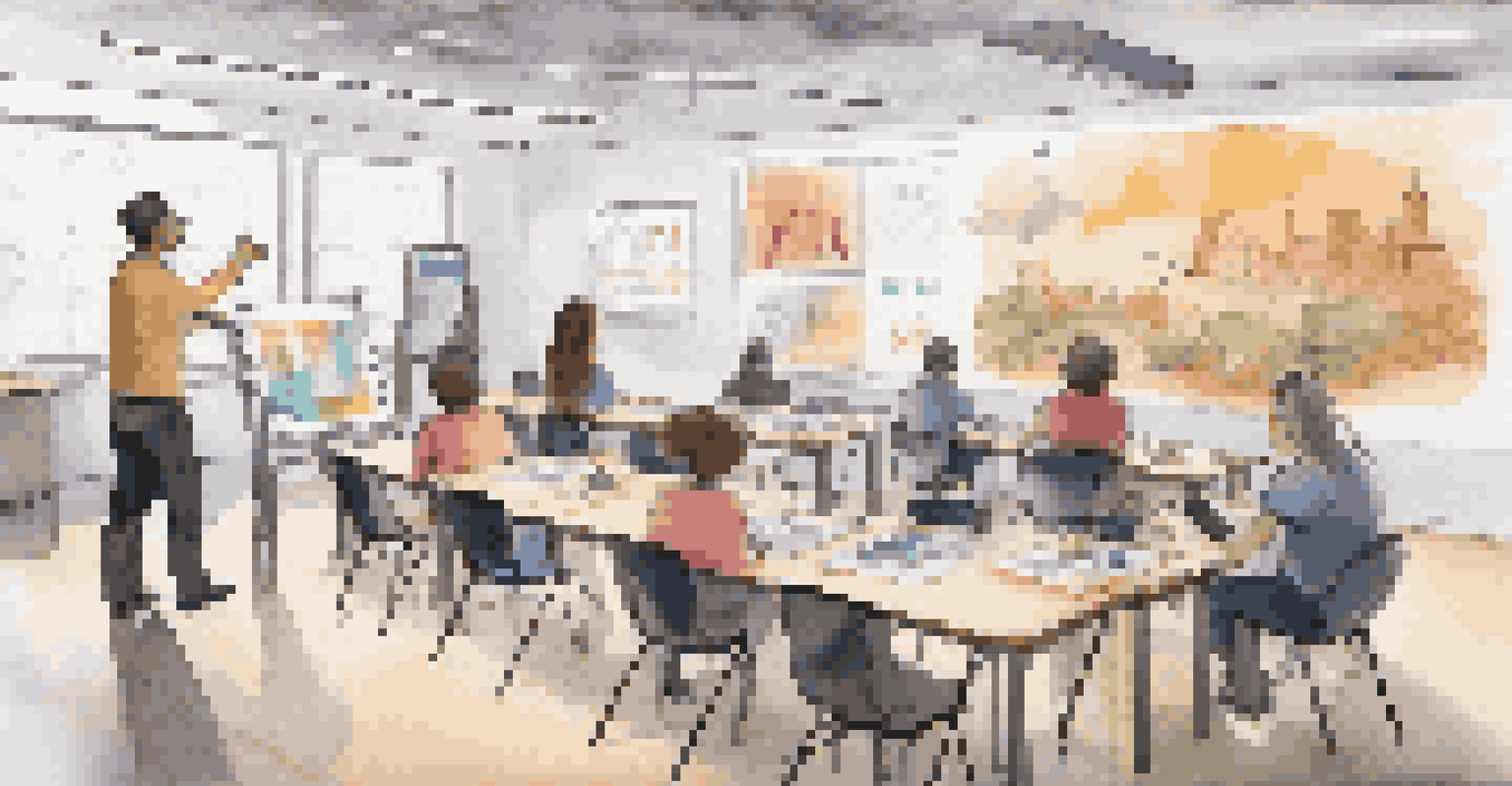Challenges of Implementing AR in Educational Institutions

Understanding Augmented Reality in Education
Augmented Reality (AR) blends digital elements with the real world, creating immersive experiences. In educational settings, it can bring complex subjects to life, allowing students to visualize concepts in a way that traditional methods cannot. For instance, imagine a biology class where students can explore the human body in 3D rather than just reading about it in textbooks.
Augmented Reality has the power to transform education, making learning an immersive experience rather than a passive one.
However, the introduction of AR is not as straightforward as it sounds. Many institutions grapple with understanding the technology itself, leading to hesitance in implementation. This lack of familiarity can cause educators and administrators to miss out on the potential benefits AR could offer.
To successfully harness AR, schools need proper training and resources. This means investing time and effort into not just acquiring technology, but also ensuring that faculty are equipped to use it effectively.
Financial Constraints in Adopting AR Technologies
One of the most significant challenges educational institutions face is financial constraint. Implementing AR technology often requires substantial investment in hardware and software, which can be daunting for many schools operating on tight budgets. For example, purchasing AR headsets for an entire class can quickly add up.

Additionally, there are ongoing costs associated with maintaining and updating AR systems. Schools may find it difficult to allocate funds for continuous training and support, which are crucial for long-term success. This financial burden can deter even the most enthusiastic educators from pursuing AR initiatives.
AR Enhances Learning Experiences
Augmented Reality can bring complex subjects to life, allowing students to visualize concepts more effectively than traditional methods.
To overcome these hurdles, schools can explore partnerships with tech companies or seek grants specifically aimed at enhancing educational experiences. Collaborative efforts can alleviate some financial stress and make AR more accessible.
Lack of Infrastructure and Technical Support
Implementing AR in educational settings requires a robust technological infrastructure. Many schools still rely on outdated systems, making it difficult to support new AR technologies. Insufficient internet bandwidth or inadequate devices can lead to frustrating experiences that detract from the learning process.
Technology will not replace great teachers, but technology in the hands of great teachers can be transformational.
Moreover, technical support is essential when integrating new technologies. Without a dedicated IT team, troubleshooting issues can become a significant barrier. Educators may feel overwhelmed if they don’t have immediate assistance at their disposal, which can hinder their ability to effectively incorporate AR into their lessons.
Investing in infrastructure and support is crucial for successful AR adoption. Schools must prioritize upgrading their systems and ensuring reliable tech support to create an environment conducive to innovative learning.
Resistance to Change Among Educators
Change is often met with resistance, and this is particularly true in educational settings. Many educators are accustomed to traditional teaching methods and may be hesitant to embrace AR. This reluctance can stem from a fear of the unknown or a belief that new technology may not enhance learning.
To ease this transition, schools can foster a culture of innovation by providing training and showcasing success stories. When teachers see their peers successfully implementing AR, they may feel more inclined to jump on board. For instance, hosting workshops where teachers can experience AR firsthand can spark enthusiasm.
Financial Barriers to AR Adoption
Many educational institutions face significant financial constraints that hinder their ability to implement and maintain AR technologies.
Ultimately, it’s about building confidence. With the right support and encouragement, educators can become advocates for AR in their classrooms, enriching the learning experience.
Curriculum Integration Challenges
Integrating AR into existing curricula poses its own set of challenges. Many teachers struggle to find ways to seamlessly incorporate AR experiences without disrupting the flow of their lessons. It requires careful planning and creativity to ensure that AR complements traditional teaching methods.
Moreover, educators must align AR content with learning objectives and standards. This alignment can be time-consuming and may require additional resources to find or develop appropriate AR materials. Schools may feel overwhelmed by the task of creating a cohesive learning experience that includes AR.
Collaboration among educators can help ease this integration. By sharing resources and ideas, teachers can develop AR-enhanced lessons that are not only engaging but also educationally sound.
Student Engagement and Accessibility Concerns
While AR has the potential to boost student engagement, it is essential to consider accessibility. Not all students learn the same way, and some may find AR experiences disorienting or challenging. Schools must ensure that AR content is inclusive and caters to diverse learning needs.
Additionally, not every student has equal access to the necessary devices, which can create disparities in learning opportunities. For instance, if only some students have access to AR headsets, the benefits of the technology may not be felt equally across the classroom.
Need for Robust Tech Support
Successful AR integration requires a strong technological infrastructure and dedicated technical support to assist educators in the implementation process.
To address these concerns, educators should strive for inclusivity in their AR implementation. This could involve providing alternative learning methods or ensuring that AR experiences are adaptable to various learning styles.
Future Directions for AR in Education
Despite the challenges, the future of AR in education is promising. As technology continues to evolve, we can expect more user-friendly and affordable AR solutions that cater specifically to educational needs. This could lead to more widespread adoption in classrooms worldwide.
Moreover, ongoing research and development in AR technologies will likely yield new applications for learning. Schools can look forward to enhanced educational experiences that make learning more interactive and enjoyable.

Ultimately, the key lies in collaboration among educators, tech companies, and policymakers. By working together, we can overcome the current challenges and unlock the full potential of AR in education.